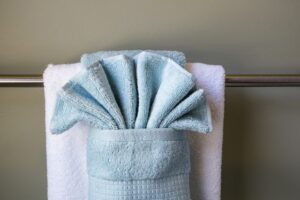How Often Should You Reuse a Bath Towel? 3- 4 Times!
For optimal hygiene, you should reuse a bath towel no more than three to four times between washes.
When you use a bath towel, it removes dead skin cells and bacteria from your skin. These cells and bacteria can remain on the towel after use, making it a breeding ground for germs.
When you reuse the towel too many times without washing it, you could be putting these germs back onto your skin.
Therefore, it is recommended to limit the reuse of your bath towel to three or four times before washing it.
Remember, it’s crucial to let your towel dry completely between uses. This is because a damp towel is a perfect environment for bacteria, mold, and mildew to grow.
Not only can this cause your towel to smell, but it can also potentially lead to skin infections. Therefore, always hang your bath towel in a place where it can fully dry out before you use it again.

Key Takeaway
Factors To Consider When Deciding On Towel Reuse Frequency
Considering factors such as personal hygiene, use environment, and towel maintenance, determining the ideal frequency for reusing a bath towel is essential.
These considerations help maintain sanitation and comfort levels, ensuring a hygienic and pleasant bathing experience.
Are you someone who finds joy in using a fresh, fluffy bath towel every single time you step out of the shower? Or do you tend to reuse your towel a few times before tossing it in the laundry hamper?
The frequency at which you reuse a bath towel is a matter of personal preference and consideration of various factors. We’ll explore the key factors that can help you determine how often you should reuse your bath towel.
Personal Preferences And Comfort Levels:
- Personal hygiene preferences: Some individuals prioritize using a fresh towel after each use to maintain a pristine feeling of cleanliness. Others may feel comfortable reusing their towel a few times, considering factors like convenience and environmental impact.
- Sensitivity to odors: If you’re particularly sensitive to damp or musty odors, you may prefer using a fresh towel every time to avoid any unpleasant smells.
- Skin conditions: People with certain skin conditions or sensitivities may opt for using a clean towel after each use to prevent any potential irritation or infection.
- Personal comfort: Ultimately, personal preference and comfort play a significant role in determining how often you should reuse your towel. Listen to your body and choose a frequency that aligns with your comfort levels.
Climate And Humidity Conditions:
- Humidity levels: High humidity can lead to towels taking longer to dry, potentially promoting bacterial growth. In such conditions, it may be advisable to use a fresh towel more frequently.
- Warm and humid climates: In regions where temperatures and humidity levels are consistently high, towels may become prone to faster bacterial growth. Reusing them for an extended period may not be ideal.
- Dry climates: In areas with lower humidity levels, towels may dry more quickly, reducing the risk of bacterial growth. Reusing them a few times may be more feasible in this scenario.
Remember, irrespective of your chosen frequency, it’s crucial to maintain proper towel hygiene by allowing them to dry thoroughly between uses. This helps minimize any potential bacterial growth.
By taking into account your personal preferences, comfort levels, and the climate and humidity conditions, you can determine the ideal towel reuse frequency that suits your needs.
So go ahead, towel off with confidence, knowing that you’ve found a reuse frequency that leaves you feeling refreshed and keeps your towels in tip-top shape.
Health Considerations For Towel Reuse
Reusing bath towels requires careful consideration of health factors. Discover the optimal frequency for towel reuse to maintain hygiene and wellness.
The Role Of Bacteria In Towel Contamination
- Towels are common sources of contamination, as they come into contact with our bodies and absorb moisture.
- Bacteria thrive in warm and damp environments, making towels an ideal breeding ground for them.
- The primary culprits are coliform bacteria, which include E. Coli, and staphylococcus aureus.
- When towels are used multiple times without washing, the bacteria left behind can multiply rapidly.
- These bacteria can potentially cause skin infections, respiratory illness, and gastrointestinal problems.
How Frequently Towels Should Be Washed For Hygiene Purposes?
- To maintain good hygiene, it is recommended to wash bath towels after three to four uses.
- Regular washing helps to remove bacteria and keep towels free from odors.
- Individuals with compromised immune systems or skin conditions may need to wash towels more frequently.
- It is essential to allow towels to dry completely between uses to prevent bacterial growth.
- Using separate towels for different family members can help reduce the spread of bacteria.
Remember, proper towel hygiene is crucial for maintaining good health and preventing the spread of harmful bacteria. By following these guidelines, you can ensure that your towels remain clean, fresh, and safe to use.
Economical Benefits Of Towel Reuse
Reusing bath towels is a cost-effective practice that can bring about economic benefits. By extending the lifespan of towels through reuse, individuals can save money on frequent replacements and reduce their overall consumption.
Regularly washing and drying towels can maintain their hygiene, allowing for longer use and additional cost savings.
Towels are an essential part of our daily hygiene routine. But have you ever wondered how often you should reuse your bath towel? Beyond the environmental benefits, reusing your towel also offers numerous cost-saving advantages.
We will explore the economical benefits of towel reuse, focusing on decreasing laundry costs and water usage, as well as prolonging the lifespan of your towels.
Decreasing Laundry Costs And Water Usage:
- Reusing towels reduces the frequency of laundry loads, translating to significant savings on water, electricity, and detergent costs.
- When you reuse a towel, you minimize the need for constant laundering, resulting in lower utility bills and a decreased environmental footprint.
- By extending the time between washes, the repetitive wear and tear on towels are reduced, potentially saving you money on towel replacements in the long run.
Prolonging The Lifespan Of Towels:
- Repeated washing and drying can lead to fraying, fading, and overall deterioration of towels. However, reusing them can help extend their lifespan.
- Each time you launder a towel, the fibers weaken, decreasing its absorbency and softness. By reusing towels, you avoid subjecting them to unnecessary wear and tear.
- Not only will reusing towels save you money on replacing them, but it also ensures that your towels remain in optimal condition for a longer period.
The economical benefits of towel reuse are undeniable. By decreasing laundry costs and water usage, as well as prolonging the lifespan of towels, you can make a positive impact on both your wallet and the environment. So go ahead, give your towel a second chance and reap the benefits of towel reuse today.
Signs it’s Time to Replace a Bath Towel
Indicators of Bacterial Growth or Hygiene Concerns:
Persistent Odor:
If your bath towel continues to emit a musty or unpleasant odor even after washing, it may indicate bacterial growth. Bacteria thrive in damp environments, and towels that don’t dry completely between uses can become a breeding ground for microbes.
Discoloration:
Noticeable discoloration, especially dark or mold-like spots, may suggest the presence of mildew or bacteria. Regular washing should remove most stains, but persistent discoloration may indicate a need for replacement.
Skin Irritation:
If you notice skin irritation, redness, or itching after using a towel, it could be a sign of bacterial contamination. Over time, towels accumulate dead skin cells, oils, and other organic matter that can lead to skin problems if not properly cleaned.
Unpleasant Texture:
Towels that feel slimy, rough, or unusually stiff even after washing may have accumulated bacteria and residues over time. This can compromise the towel’s ability to effectively dry your skin.
Recognizing Wear and Tear in Bath Towels:
Frayed Edges:
Over time, the edges of bath towels may start to fray, leading to a less appealing appearance and reduced functionality. If the fabric begins to unravel, it’s a clear sign that the towel is reaching the end of its lifespan.
Thinning Fabric:
Regular use and washing can lead to the gradual thinning of towel fabric. If you notice that your towel has become significantly thinner or feels less plush than when you first bought it, it might be time to replace it.
Loss of Absorbency:
Towels are designed to absorb moisture effectively. If your towel no longer dries you as well as it used to, or if it feels perpetually damp even after use, it may have lost its absorbency due to wear and tear.
Loose or Pulled Threads:
Examine your towel for loose or pulled threads. These can compromise the structural integrity of the fabric and lead to further damage over time. If you notice significant thread damage, it’s a good indication that the towel needs to be replaced.
Fading Colors:
Continuous exposure to sunlight, frequent washing, and the use of harsh detergents can cause bath towels to lose their vibrant colors over time. Fading may not only affect the aesthetic appeal but can also be a sign of fabric deterioration.
In general, if your bath towel exhibits a combination of these signs, it’s likely time to invest in a new one to ensure optimal hygiene, functionality, and comfort.
Regularly washing and properly caring for your towels can extend their lifespan, but they will inevitably wear out with extended use.
The Environmental Impact Of Towel Reuse
Reusing bath towels is not only environmentally friendly but also economical. With proper maintenance and regular washing, a towel can be reused multiple times before needing to be replaced, reducing waste and minimizing the ecological impact.
Statistics on water and energy consumption in the laundry process:
- Reusing bath towels can significantly reduce water and energy consumption during the laundry process.
- Washing towels less frequently means fewer loads of laundry, which conserves both water and energy.
- On average, washing and drying a load of laundry consumes around 40 gallons of water and a considerable amount of electricity.
- By reusing towels, you can reduce the number of loads per week and conserve these valuable resources.
The carbon footprint of towel production and disposal:
- The production and disposal of bath towels contribute to carbon emissions and environmental degradation.
- According to research, manufacturing new towels requires a significant amount of energy and resources, including water and raw materials.
- Additionally, the disposal of old towels leads to waste accumulation in landfills, which releases harmful greenhouse gases.
- By reusing towels, you can help reduce the demand for new towel production and minimize the environmental impact associated with their disposal.
Considering the statistics on water and energy consumption in the laundry process, as well as the carbon footprint of towel production and disposal, making a conscious effort to reuse bath towels can greatly benefit the environment.
By doing so, you contribute to conserving precious resources and minimizing carbon emissions, helping create a more sustainable future.
So, why not extend the life of your towels and reduce their environmental impact?
Tips For Hygienic Towel Reuse
Discover the best practices for reusing bath towels hygienically. Learn how often you should reuse a towel while maintaining cleanliness and freshness.
Proper Towel Drying And Storage Techniques
Having proper towel drying and storage techniques is crucial for maintaining the hygiene of your towels.
Here are some tips to follow:
- After using a bath towel, make sure to hang it in a well-ventilated area to allow it to dry completely. Avoid folding or bunching the towel, as this can trap moisture and create a breeding ground for bacteria.
- If possible, choose a towel rack or hook that allows for some distance between each towel, promoting faster drying time and preventing the transfer of germs.
- Avoid drying towels in humid or damp areas such as bathrooms with poor ventilation. Moisture can lead to musty odors and mold growth on the towel.
- It’s essential to avoid reusing a towel when it is still wet. Using a wet towel can spread bacteria and lead to unpleasant smells.
- Ensure that the towel is completely dry before storing it. A damp towel can provide an ideal environment for bacterial growth.
- If you have multiple family members sharing a bathroom, consider using different colored towels or personalized hooks to avoid confusion and prevent the interchange of towels.
Following these proper drying and storage techniques will help maintain the cleanliness and hygiene of your bath towels, ensuring they are ready for reuse.
Using Separate Towels For Different Purposes
Using separate towels for different purposes is an effective way to maintain hygiene and prevent the transfer of bacteria.
Here’s how you can do it:
- Have designated towels for specific purposes such as body towels, hand towels, and hair towels. This prevents the spread of germs from one part of the body to another.
- Use hand towels for drying your hands only. The skin on our hands can harbor more bacteria, and using a dedicated towel for hand drying can prevent the transfer of germs to other areas of the body.
- Consider using a separate towel for drying your face. The skin on our face is more sensitive, and using a designated face towel can reduce the risk of skin irritation and breakouts.
- If you have been working out or engaging in activities that cause excessive sweating, it’s advisable to use a fresh towel to prevent bacteria from multiplying on the damp towel.
- For families with children or individuals with skin conditions, it can be beneficial to have separate towels to minimize the risk of cross-contamination.
By using separate towels for different purposes, you can maintain better hygiene and minimize the transfer of bacteria, ensuring a clean and refreshing experience after each use.
Addressing Common Concerns And Myths About Towel Reuse
Reusing a bath towel is not only environmentally friendly but also hygienic. Washing your towel every 3-4 uses is sufficient to maintain cleanliness and freshness, debunking common concerns and myths surrounding towel reuse.
Dispelling Misconceptions About Towel Cleanliness
Towels should only be used once
Contrary to popular belief, reusing towels multiple times before washing them does not pose a significant hygiene risk.
As long as towels are allowed to dry completely between uses, they can be reused without fear of spreading bacteria or causing skin issues.
Towels become dirty after just one use
While towels do absorb water, they are not automatically dirty after each use. As long as they are hung up to dry properly, towels can be used more than once without compromising cleanliness.
Sharing towels is unhygienic
The fear of sharing towels causing the transmission of germs is often exaggerated. As long as each person has their own designated towel and they are washed regularly, there is minimal risk of transmitting harmful bacteria.
Towels should be washed after every use
Washing towels after every single use is not necessary and only leads to unnecessary water and energy consumption.
By reusing towels a few times before washing, you can contribute to environmental sustainability without sacrificing cleanliness.
Addressing Concerns About Towel Odor And Maintenance
- Odor buildup in towels: Many believe that reusing towels causes them to develop a musty odor. However, proper towel care, including allowing towels to dry completely between uses and avoiding folding them while damp, can prevent unpleasant odors.
- Preventing bacteria growth: Concerns about bacterial growth in reused towels can be addressed by ensuring that towels are hung up to dry and washed frequently. Regular washing with the appropriate detergent will eliminate any bacteria that may accumulate over time.
- Maintaining towel freshness: To keep your towels smelling fresh, consider adding a small amount of white vinegar or baking soda to the wash cycle. These natural ingredients can help eliminate any lingering odors and keep your towels soft and fluffy.
- Treating stained towels: Stains on towels can be easily treated by presoaking them in a mixture of detergent and warm water before washing. For stubborn stains, you can also try using a stain remover or lemon juice to restore your towels’ cleanliness.
- Extending towel lifespan: To prolong the lifespan of your towels, avoid using fabric softeners, as they can reduce absorbency over time. Additionally, avoid washing towels with clothing items that have zippers or hooks that could potentially snag or damage the towel fibers.
Remember, reusing bath towels is not only practical and eco-friendly but also perfectly hygienic if proper care and maintenance practices are followed. So, feel free to enjoy the benefits of towel reuse without any concerns about cleanliness or odor.
Conclusion
The frequency of reusing bath towels depends on personal preference and hygiene standards. While some people may prefer to use a fresh towel every day, others find it acceptable to reuse their towels for a few days or even a week.
However, it is important to keep in mind good hygiene practices. Towels should be hung to dry between uses to prevent bacterial growth and should be washed regularly.
By following this routine, you can maintain a healthy balance between reducing water consumption and ensuring cleanliness. Additionally, using high-quality towels made of absorbent materials can help extend their lifespan.
Ultimately, the decision of how often to reuse a bath towel rests with the individual, taking into consideration their personal comfort, cleanliness, and environmental concerns.






